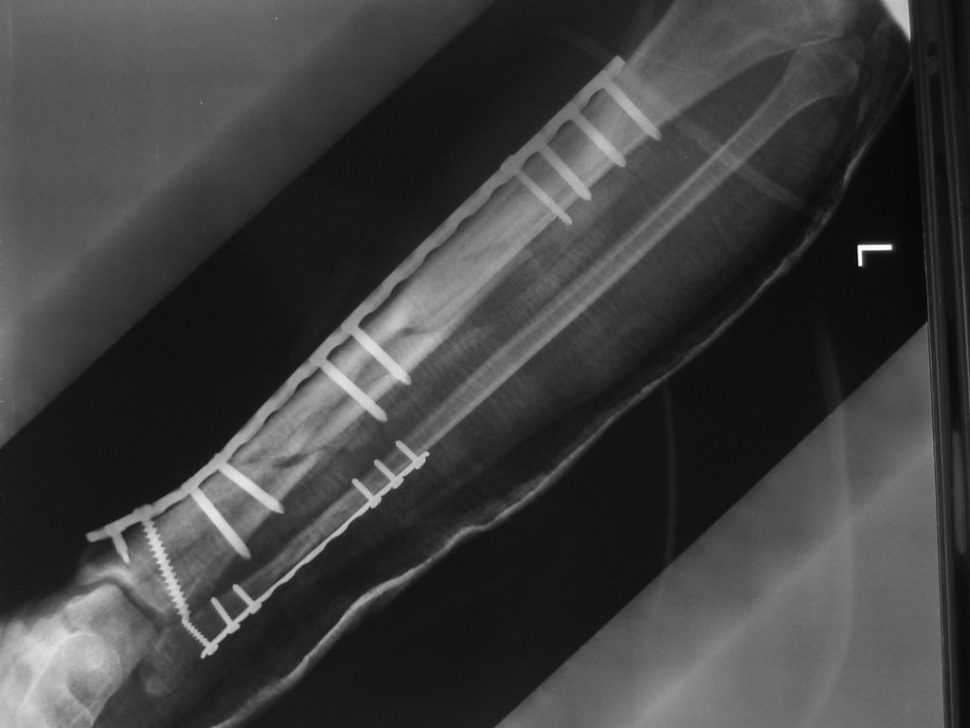Researchers are on the edge of making another medical breakthrough with the development of a biodegradable coating that will improve bone metal implants in the future.
A bone injury is not something that should be taken lightly by anyone. It is considered as one of the most painful and slow-healing injuries in medicine. Unlike normal flesh wounds that heal within a few days after being patched, fractures take weeks or months to heal, and often require metal implants to support healing.
Typically, medical implants are designed using surgical stainless steels, titanium alloys, and polymers. They are specifically made to support the body in repairing fractured bones. Without metal implants, injured bones may grow weak or worse, may not heal properly.
While metallic non-degradable implants are crucial in serious bone injuries, they have severe side effects that are harmful to people. Long-term exposure to these metallic alloys increases the risk of complications such as inflammation due to the release of metal ions from metal corrosion.
@astar_research is now developing #biodegradable coating for #metalimplants !Click To TweetTo lessen bone complications, researchers from Singapore’s A*STAR Research is now working on a biodegradable coating that could significantly improve the usage of metal implants.
Biodegradable Coating for Magnesium-based Metal Implants
For years, medical researchers have been looking for ways to lower the risk of bone implant complications.
In a paper published by Bobby Kannan, a professor from the James Cook University‘s School of Engineering and Physical Sciences in Queensland, Australia, he said that problems associated with non-degradable implants pushed the interest of researchers towards biodegradable materials. He said:
“The problems associated with non-degradable implants have led to a growing interest in biodegradable materials. The idea is that the implant remains in the body i.e., serving its purpose during the healing process, and then naturally degrades in the body fluid and excretes without any complication.”
Thus, the A*STAR team was led to the development of a biodegradable implant that is considered a more suitable mechanical match with bone, and might also aid in the actual healing process.
One metallic material being considered by researchers as a good candidate for biodegradable metal implants is magnesium. According to Kannan:
“Magnesium, a light weight metallic material, is a potential material for biodegradable implant applications, since magnesium degrades in body fluid and the degradation product is non-toxic and soluble in body fluid. Importantly, magnesium has similar mechanical properties to natural bone, especially the compressive yield strength of magnesium is closer to that of natural bone than that of the commonly used metallic biomaterials.”
However, Sandor Nemeth of the A*STAR team explained that while magnesium is a strong and flexible metal, its reactivity makes it impossible to use it alone as a metal implant inside the body because it would corrode quickly.
“Due to the high degradation rate of pure magnesium in near neutral pH and high chloride concentration of body fluid, magnesium cannot be used as an implant in its purest form. The high electronegative potential of magnesium and the non-protective degradation product (oxide/hydroxide) contribute to its high degradation rate.
The extremely high degradation rate of magnesium in body fluid not only dissolves the implant before the tissues sufficiently heal, but it also creates hydrogen (a cathodic reaction) gas pockets which potentially affect the healing process,” Kannan elaborated in his paper entitled “An Outlook on Magnesium-Based Biodegradable Implants”.
Still, the corrosive property of magnesium is viewed by the A*STAR team as an advantage as the rate of degradation could be controlled. This could be possible with the help of “a coating that degrades slowly enough to support the bones during healing, then safely disperses when the job is done.”
Key Components of the Biodegradable Coating for Metal Implants
Nemeth together with his Ph.D. student, Sara Kaabi, at the A*STAR Singapore Institute of Manufacturing Technology, partnered with Ming Jen Tan of Nanyang Technological University to search for a potential coating solution to magnesium-based metal implants.
“We turned to calcium phosphate because in nature this inorganic material is a key component of bone and other strong materials such as sea shells,” says Nemeth.
By adding carbon-based organic polymers to the mix, the researchers can create a composite coating that produces numerous benefits.
For instance, changing the combination of components will make it possible for the properties of metal implants and biodegradable materials to be adjusted depending on various medical requirements. This could help avoid the brittleness of purely inorganic coatings.
Furthermore, cultured cell studies suggest that calcium phosphate can significantly contribute to the healing process of a fractured bone by providing some raw materials to sustain bone growth.
Coating the magnesium alloy can be done using pressurized hot water. It is a simple one-step process that could be crucial for commercial-scale production in the future. Nemeth confirmed that their research is now entering the animal trial stage. However, their team would need an industry partner to proceed.
Currently, the A*STAR team is also exploring the possibilities of incorporating antibiotics and other drugs to the coating to increase its healing potentials.

















Comments (0)
Least Recent